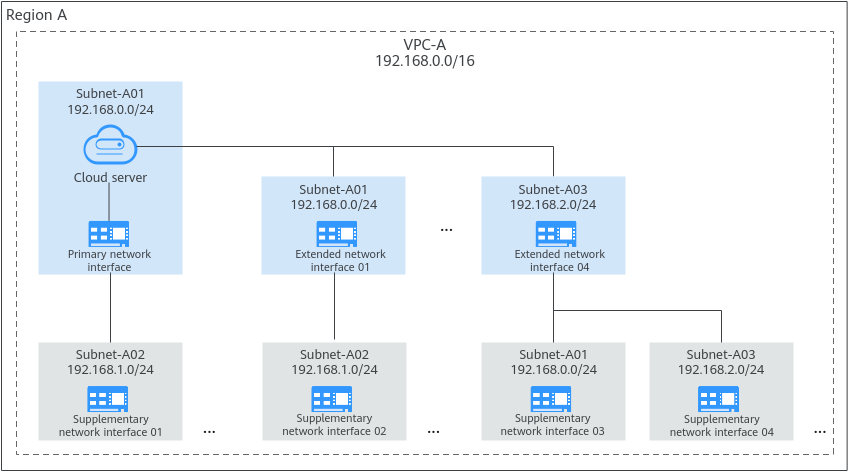Supplementary Network Interface Overview
Supplementary network interfaces are a supplement to elastic network interfaces. If the number of elastic network interfaces that can be attached to your cloud server cannot meet your requirements, you can use supplementary network interfaces, which can be attached to VLAN subinterfaces of elastic network interfaces.
Application Scenarios
The number of elastic network interfaces that can be attached to a cloud server is limited. If the cloud server specifications support supplementary network interfaces, you can attach supplementary network interfaces to the elastic network interfaces as needed.
Supplementary network interfaces are attached to VLAN subinterfaces of elastic network interfaces. You can attach multiple supplementary network interfaces to a cloud server. Each supplementary network interface belongs to a different subnet in the same VPC. They have dedicated private IP addresses and EIPs and process the internal, external, and management traffic of the cloud server. You can configure access control policies and routes for each subnet, and define security group rules for each supplementary network interface to isolate networks and service traffic.
Figure 1 shows the attachment relationship. Both the primary and extended network interfaces of an ECS can have supplementary network interfaces attached. In this example, the cloud server has one primary network interface and four extended network interfaces. If the number of elastic network interfaces that can be attached to a cloud server reaches the upper limit, you can attach supplementary network interface 01 to the primary network interface, supplementary network interface 02 to extended network interface 01, and supplementary network interfaces 03 and 04 to extended network interface 04. So there are four supplementary network interfaces. Elastic network interfaces and supplementary network interfaces can be in different subnets. In this example, supplementary network interface 04 and extended network interface 04 are in Subnet-A03, but supplementary network interface 03 is in Subnet-A01.
Constraints
- A maximum of 256 supplementary network interfaces can be attached to a cloud server of certain specifications. The number of supplementary network interfaces that can be attached to a cloud server varies by server specification. ECS specifications that support supplementary network interfaces are as follows:
ECS: C7, S7, and M7 series. For details, see the maximum supplementary network interfaces of an ECS in A Summary List of x86 ECS Specifications.
Cloud container: c6ne series
- A cloud server cannot use Cloud-Init through the private IP addresses of its supplementary network interfaces.
- A supplementary network interface cannot have a virtual IP address bound.
- The flow logs of supplementary network interfaces cannot be collected separately. Their flow logs are generated together with their network interfaces.
Feedback
Was this page helpful?
Provide feedbackThank you very much for your feedback. We will continue working to improve the documentation.See the reply and handling status in My Cloud VOC.
For any further questions, feel free to contact us through the chatbot.
Chatbot






